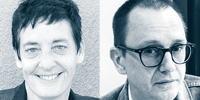
Welcome to a special issue of POSITIVELY AWARE, prepared for AIDS 2018—the 22nd International AIDS Conference in Amsterdam. Given developments in the field of HIV cure research (see the Winter 2017 issue of POSITIVELY AWARE), we thought it would be interesting and exciting to go behind the scenes for a close look at a planned clinical trial that aims to assess whether a combination of new interventions can enhance control of HIV in the absence of ongoing treatment.
The trial is an example of a growing interest in exploring combination approaches that pair novel vaccines and experimental agents aimed at the small dormant pool of residual virus, called the latent HIV reservoir. A number of such studies are planned or already underway around the world.
Our choice was San Francisco, an early epicenter of the AIDS epidemic, where the trial protocol has been developed by a University of California at San Francisco (UCSF) team led by HIV cure pioneer Dr. Steven Deeks, under the auspices of the amfAR Institute for HIV Cure Research. The goal is to probe the possibility of achieving a period of remission, or “post-treatment control” off antiretroviral therapy (ART), a scenario short of a full cure, or complete eradication, but a major step. Scientists hope that it might one day become feasible to induce strict long-term control of HIV by the immune system.
The research partly builds on studies of elite controllers—rare individuals whose immune systems control HIV to very low levels without ART. These individuals offer clues about the types of immune protection that researchers may need to try and mimic or further improve in new trials.
Other lessons are being learned from even rarer cases of individuals with only trace amounts of HIV in their bodies due to extremely early HIV treatment, or stem cell transplants for cancers. Such people have been able to interrupt treatment and go for an extended period before the virus rebounds. In this issue, we spotlight the stories of Clark Hawley and Luis Canales, who are among the earliest treated adult cases. Both men kindly talked to us for this issue about why they are participating in cure research.
It’s important for us to stress that the proposed clinical trial we highlight in the magazine is only one among many such studies and narratives playing out in the cure research field. We wanted to give a sense of what’s behind the development of a cure study: the scientific questions, logistical hurdles, and intersecting human stories—a window into the process. It’s not to single out UCSF as being above any other research institution, or to imply that this remission study is more likely to succeed than another.
At press time in early May, the UCSF trial was moving ahead, but it hadn’t yet been given final FDA approval. Right now, the trial is expected to enroll in the fall.
At this early stage of our cure efforts, it’s often the case that important lessons are learned, even when interventions don’t work. This study will look at the safety and efficacy of new interventions in humans. We wanted to take you to the new frontlines of the battle.
In February, the UCSF team allowed us unfettered access to meet with community volunteers at their SCOPE cohort who play a heroic role in their studies, and the various teams of scientists, doctors, nurses, technicians, and watchdog groups who are now collaborating to plan the new trial. What’s readily apparent is a shared passion and global concern for ending HIV, doing science right, and making sure vulnerable and impacted communities are invited in now to become engaged partners in this effort.
We’re also hoping this special look at what’s coming down the pipeline will inspire you to learn more about HIV cure and remission research, and to share this information with others in your community. We need HIV-positive individuals and the global public to actively participate and help shape such research.
A final note: We’ll be putting an expanded digital version of this special issue at positivelyaware.com.
In solidarity,
Anne-christine d’Adesky
Richard Jefferys

